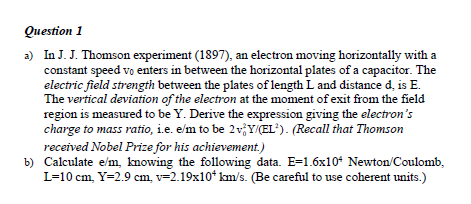Question 1 a) In J. J. Thomson experiment (1897), an electron moving horizontally with a constant speed vo enters in between the horizontal plates of a capacitor. The electric field strength between the plates of length L and distance d, is E. The vertical deviation of the electron at the moment of exit from the field region is measured to be Y. Derive the expression giving the electron's charge to mass ratio, i.e. e/m to be 2v,Y/CEL). (Recall that Thomson received Nobel Prize for his achievement.) b) Calculate e/m, knowing the following data. E=1.6x10* Newton/Coulomb, L=10 cm, Y=2.9 cm, v=2.19x10* km/s. (Be careful to use coherent units.)
Question 1 a) In J. J. Thomson experiment (1897), an electron moving horizontally with a constant speed vo enters in between the horizontal plates of a capacitor. The electric field strength between the plates of length L and distance d, is E. The vertical deviation of the electron at the moment of exit from the field region is measured to be Y. Derive the expression giving the electron's charge to mass ratio, i.e. e/m to be 2v,Y/CEL). (Recall that Thomson received Nobel Prize for his achievement.) b) Calculate e/m, knowing the following data. E=1.6x10* Newton/Coulomb, L=10 cm, Y=2.9 cm, v=2.19x10* km/s. (Be careful to use coherent units.)
College Physics
1st Edition
ISBN:9781938168000
Author:Paul Peter Urone, Roger Hinrichs
Publisher:Paul Peter Urone, Roger Hinrichs
Chapter18: Electric Charge And Electric Field
Section: Chapter Questions
Problem 53PE: A simple and common technique for accelerating electrons is shown in Figure 18.55, where there is a...
Related questions
Question
100%

Transcribed Image Text:Question 1
a) In J. J. Thomson experiment (1897), an electron moving horizontally with a
constant speed vo enters in between the horizontal plates of a capacitor. The
electric field strength between the plates of length L and distance d, is E.
The vertical deviation of the electron at the moment of exit from the field
region is measured to be Y. Derive the expression giving the electron's
charge to mass ratio, i.e. e/m to be 2v,Y/CEL). (Recall that Thomson
received Nobel Prize for his achievement.)
b) Calculate e/m, knowing the following data. E=1.6x10* Newton/Coulomb,
L=10 cm, Y=2.9 cm, v=2.19x10* km/s. (Be careful to use coherent units.)
Expert Solution
This question has been solved!
Explore an expertly crafted, step-by-step solution for a thorough understanding of key concepts.
Step by step
Solved in 2 steps with 2 images

Knowledge Booster
Learn more about
Need a deep-dive on the concept behind this application? Look no further. Learn more about this topic, physics and related others by exploring similar questions and additional content below.Recommended textbooks for you

College Physics
Physics
ISBN:
9781938168000
Author:
Paul Peter Urone, Roger Hinrichs
Publisher:
OpenStax College

Physics for Scientists and Engineers
Physics
ISBN:
9781337553278
Author:
Raymond A. Serway, John W. Jewett
Publisher:
Cengage Learning

Physics for Scientists and Engineers with Modern …
Physics
ISBN:
9781337553292
Author:
Raymond A. Serway, John W. Jewett
Publisher:
Cengage Learning

College Physics
Physics
ISBN:
9781938168000
Author:
Paul Peter Urone, Roger Hinrichs
Publisher:
OpenStax College

Physics for Scientists and Engineers
Physics
ISBN:
9781337553278
Author:
Raymond A. Serway, John W. Jewett
Publisher:
Cengage Learning

Physics for Scientists and Engineers with Modern …
Physics
ISBN:
9781337553292
Author:
Raymond A. Serway, John W. Jewett
Publisher:
Cengage Learning

Physics for Scientists and Engineers, Technology …
Physics
ISBN:
9781305116399
Author:
Raymond A. Serway, John W. Jewett
Publisher:
Cengage Learning

Physics for Scientists and Engineers: Foundations…
Physics
ISBN:
9781133939146
Author:
Katz, Debora M.
Publisher:
Cengage Learning
